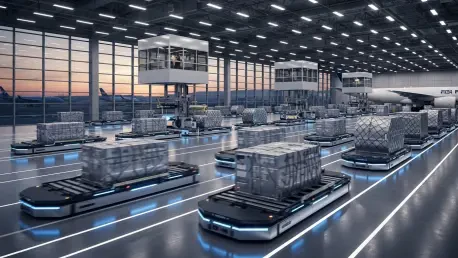The Rise of Robotics in German Airport Cargo Operations
Imagine a bustling airport cargo terminal where autonomous robots glide seamlessly among human workers and vehicles, navigating unpredictable obstacles to ensure timely delivery of critical shipments. This is no longer a vision of the future but a reality unfolding at major German airports like Munich (MUC) and Stuttgart (STR). The air cargo sector in Germany, a vital cog in global logistics, is undergoing a transformative shift as robotics move from theoretical concepts to practical, live operations. Traditionally reliant on manual labor and complex coordination, the industry faces mounting pressures from labor shortages and the need for heightened efficiency in dynamic airside environments.
This transformation is spearheaded by the Digital Testbed Air Cargo (DTAC) project, led by the Fraunhofer Institute for Material Flow and Logistics (IML). With substantial funding of €13.7 million from the German Federal Ministry for Digitalization and Government Modernization (BMDS), the initiative has deployed five autonomous robots at key airports to test their capabilities in real-world settings. These robots operate alongside humans and vehicles, tackling the intricate challenges of live logistics where split-second decisions are crucial.
Key technologies driving this change include autonomous navigation systems and modular control frameworks that allow for seamless integration into existing airport operations. IML, a central player in this innovation, focuses on creating scalable solutions that address the operational complexities of air cargo handling. As a critical segment of global supply chains, air cargo logistics demands precision and adaptability, making the integration of robotics not just an enhancement but a potential game-changer for the industry.
Trends and Innovations Driving Robotic Integration
Emerging Technologies and Operational Shifts
The adoption of robotics in airport cargo operations is shaped by a pressing need for autonomy in highly dynamic settings. Unlike controlled warehouse environments, airports present unpredictable challenges such as sudden obstacles, fluctuating traffic patterns, and human interactions. Robots must independently navigate these disruptions to maintain operational flow, a capability being refined through real-world testing at German hubs.
Innovations like IML’s open-source software, known as openTCS, are pivotal in this shift, offering vendor-neutral fleet management that allows airports to coordinate robots from multiple manufacturers. Upcoming advancements, including AI-based predictive cargo algorithms and specialized robots for handling Unit Load Devices (ULDs), promise to further streamline processes. These developments aim to anticipate cargo needs and optimize resource allocation, reducing delays in high-pressure environments.
Beyond technology, the industry is evolving to address labor shortages by positioning robots to handle repetitive or physically taxing tasks. This supplementation of human workers is crucial in a sector where staffing gaps threaten efficiency. Moreover, the push for modular and scalable systems opens opportunities for airports of varying sizes to adopt robotics, ensuring that even smaller facilities with limited budgets can benefit from automation.
Market Insights and Growth Potential
Data from the DTAC project reveals promising outcomes, with robots successfully operating in tandem with humans and vehicles during live tests at German airports. These trials demonstrate the feasibility of robotic integration in real-time cargo handling, marking a significant milestone in logistics automation. The ability to perform tasks like container transport under actual operational conditions underscores the practical value of these systems.
Looking ahead, growth projections for robotic integration in air cargo are robust, fueled by persistent labor challenges and the demand for efficiency in time-sensitive logistics. Industry analysts anticipate a steady rise in adoption over the next few years, particularly as solutions become more cost-effective. The potential for robotics to evolve into standard infrastructure is gaining traction, supported by the recognition of the DTAC project through prestigious honors like the TIACA Sustainability Award and a top-5 finalist position at the ACW World Air Cargo Awards.
This momentum suggests a future where automation is not a luxury but a necessity for maintaining competitiveness in air cargo operations. The successful real-world testing outcomes serve as a blueprint for other regions and industries, highlighting how robotics can address immediate operational needs while paving the way for long-term transformation.
Challenges in Deploying Robotics at Airports
The integration of robotics into live airport operations is not without hurdles, particularly due to environmental inconsistencies that test system reliability. Factors such as misaligned pallets, inadequate lighting, and varying signage can disrupt robotic performance, demanding advanced sensing and adaptability to maintain seamless functionality in cargo terminals.
Technological barriers also loom large, as achieving true autonomy requires robots to handle unforeseen disruptions without human intervention. Live testing has revealed the importance of learning from minor setbacks to enhance system resilience. These small failures, encountered during real-world deployments, provide critical insights for refining navigation and decision-making algorithms, ensuring robots can cope with the fast-paced nature of airside logistics.
Market-driven challenges add another layer of complexity, with smaller airports often constrained by tight budgets that limit investment in automation. Resistance to robotics due to fears of labor displacement further complicates adoption. To counter these issues, solutions like modular, low-cost systems are being developed, alongside a narrative that emphasizes robotics as a complement to human workers. Continuous testing in diverse airport settings remains essential to address these multifaceted obstacles and build trust in automated systems.
Regulatory and Standardization Landscape
Navigating the regulatory framework is a critical aspect of deploying robotics in airport cargo operations, where compliance with safety and operational guidelines is paramount. Robots interacting with humans and vehicles in live airside environments must adhere to strict protocols to prevent accidents and ensure smooth integration. This necessitates clear policies that govern robotic behavior in such high-stakes settings.
Digital standardization plays an equally important role, with initiatives like IATA’s ONE Record pushing for unified data integration across the industry. Establishing consistent data interfaces and fleet management APIs requires collaboration among manufacturers, IT providers, cargo handlers, and regulators. Such partnerships are vital for creating an interoperable ecosystem that supports the diverse needs of airport operations.
IML’s non-profit approach further shapes this landscape by prioritizing public-benefit infrastructure over proprietary systems. By focusing on open-source solutions like openTCS, the institute fosters accessibility and customization, allowing airports to tailor robotic systems to their specific requirements. This emphasis on shared knowledge and standardized practices is instrumental in driving industry-wide acceptance of automation.
Future Outlook for Robotics in Air Cargo Logistics
The horizon for robotics in airport cargo operations appears promising, with expectations of wider adoption as systems grow more adaptable and affordable. As technology matures, even regional airports with limited resources could integrate automation, addressing operational inefficiencies and labor constraints. This democratization of robotics holds the potential to reshape logistics on a global scale.
Emerging technologies, such as AI-driven predictive operations, are set to enhance robotic capabilities, enabling airports to anticipate cargo demands and optimize workflows proactively. The transformation of robotics into core infrastructure components is a plausible outcome, positioning automation as an integral part of airport functionality rather than a peripheral tool.
However, market disruptors like shifting labor dynamics, global supply chain pressures, and economic fluctuations could influence the pace of integration. Industry collaboration and digital standardization will be key to navigating these variables, ensuring that robotics evolve into a unified, interoperable system. The collective effort to align technological advancements with operational needs will ultimately determine the trajectory of automation in air cargo logistics.
Conclusion and Recommendations
Reflecting on the journey of robotic integration in German airport cargo operations, the strides made through the DTAC project stand as a testament to innovation. Successful live testing at major hubs revealed that autonomous robots could effectively navigate dynamic challenges and support human labor. The project’s recognition through international awards further validated its impact, highlighting a path toward efficiency in a critical industry segment.
Looking ahead, stakeholders should prioritize sustained investment in real-world testing to refine robotic systems further. Collaboration across the industry to establish digital standards must remain a focus, ensuring seamless data integration and interoperability. Developing scalable solutions tailored for smaller facilities is also essential to broaden access to automation benefits.
Additionally, a strategic emphasis on actionable data interpretation emerges as a crucial next step. Beyond mere digitalization, the industry needs to harness insights from robotic operations to drive meaningful outcomes. By fostering these efforts, the air cargo sector can build on past achievements to create a future where robotics underpin operational resilience and global connectivity.









